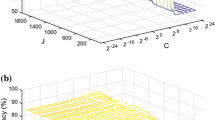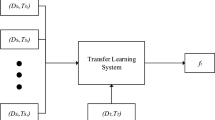Abstract
Most deep neural networks (DNNs) are trained in an over-parametrized regime. In this case, the numbers of their parameters are more than available training data which reduces the generalization capability and performance on new and unseen samples. Generalization of DNNs has been improved by applying various methods such as regularization techniques, data enhancement, network capacity restriction, injection randomness, etc. In this paper, we proposed an effective generalization method, named multivariate statistical knowledge transformation, which learns feature distribution to separate samples based on the variance of deep hypothesis space in all dimensions. Moreover, the proposed method uses latent knowledge of the target to boost the confidence of its prediction. Compared to state-of-the-art methods, the transformation of multivariate statistical knowledge yields competitive results. Experimental results show that the proposed method achieved impressive generalization performance on CIFAR-10, CIFAR-100, and Tiny ImageNet with accuracy of 91.96%, 97.52%, and 99.21% respectively. Furthermore, this method enables faster convergence during the initial epochs.








Similar content being viewed by others
Data availability
The datasets analyzed during the current study are included in this published article [22].
References
Hashemi AS, Mozaffari S, Alirezaee S (2022) Improving adversarial robustness of traffic sign image recognition networks. Displays. https://doi.org/10.1016/j.displa.2022.102277
Sitaula C, Hossain MB (2021) Attention-based VGG-16 model for COVID-19 chest X-ray image classification. Appl Intell 51:2850–2863. https://doi.org/10.1007/s10489-020-02055-x
Xi P, Guan H, Shu C et al (2020) An integrated approach for medical abnormality detection using deep patch convolutional neural networks. Vis Comput 36:1869–1882. https://doi.org/10.1007/s00371-019-01775-7
Jin B, Cruz L, Gonçalves N (2020) Deep facial diagnosis: deep transfer learning from face recognition to facial diagnosis. IEEE Access 8:123649–123661
Khosravanian A, Rahmanimanesh M, Keshavarzi P et al (2022) Level set method for automated 3D brain tumor segmentation using symmetry analysis and kernel induced fuzzy clustering. Multimed Tools Appl 81:21719–21740. https://doi.org/10.1007/s11042-022-12445-7
Wu JL, Chung WY (2022) Sentiment-based masked language modeling for improving sentence-level valence–arousal prediction. Appl Intell 52:16353–16369. https://doi.org/10.1007/s10489-022-03384-9
Willemink MJ, Koszek WA, Hardell C et al (2020) Preparing medical imaging data for machine learning. Radiology 295:4–15. https://doi.org/10.1148/radiol.2020192224
Ghadhab L, Jenhani I, Mkaouer MW, Ben Messaoud M (2021) Augmenting commit classification by using fine-grained source code changes and a pre-trained deep neural language model. Inf Softw Technol. https://doi.org/10.1016/j.infsof.2021.106566
Zheng Q, Zhao P, Li Y et al (2021) Spectrum interference-based two-level data augmentation method in deep learning for automatic modulation classification. Neural Comput Appl 33:7723–7745. https://doi.org/10.1007/s00521-020-05514-1
Pang T, Xu K, Dong Y, et al (2019) Rethinking softmax cross-entropy loss for adversarial robustness
Goodfellow I, Bengio Y, Courville A (2016) Deep learning. MIT press
Kawaguchi K, Bengio Y, Kaelbling L (2022) Generalization in deep learning. Math Asp Deep Learn. https://doi.org/10.1017/9781009025096.003
Gong C, Ren T, Ye M, Liu Q (2021) MaxUp: lightweight adversarial training with data augmentation improves neural network training. In: Proc IEEE Comput Soc Conf Comput Vis Pattern Recognit 2474–2483https://doi.org/10.1109/CVPR46437.2021.00250
Sarwar Murshed MG, Carroll JJ, Khan N, Hussain F (2022) Efficient deployment of deep learning models on autonomous robots in the ROS environment. Deep Learn Appl 3:215–243. https://doi.org/10.1007/978-981-16-3357-7_9
Stanton S, Izmailov P, Kirichenko P et al (2021) Does knowledge distillation really work? Adv Neural Inf Process Syst 9:6906–6919
Zhang C, Bengio S, Hardt M et al (2021) Understanding deep learning (still) requires rethinking generalization. Commun ACM 64:107–115. https://doi.org/10.1145/3446776
Oymak S, Soltanolkotabi M (2019) Overparameterized nonlinear learning: Gradient descent takes the shortest path? In: 36th Int Conf Mach Learn ICML 2019 2019-June:8707–8747
Gou J, Xiong X, Yu B et al (2023) Multi-target knowledge distillation via student self-reflection. Int J Comput Vis. https://doi.org/10.1007/s11263-023-01792-z
Coulibaly S, Kamsu-Foguem B, Kamissoko D, Traore D (2019) Deep neural networks with transfer learning in millet crop images. Comput Ind 108:115–120. https://doi.org/10.1016/j.compind.2019.02.003
Hinton G, Vinyals O, Dean J (2015) Distilling the knowledge in a neural network
Zheng Q, Zhao P, Zhang D, Wang H (2021) MR-DCAE: manifold regularization-based deep convolutional autoencoder for unauthorized broadcasting identification. Int J Intell Syst 36:7204–7238. https://doi.org/10.1002/int.22586
Zheng Q, Zhao P, Wang H et al (2022) Fine-grained modulation classification using multi-scale radio transformer with dual-channel representation. IEEE Commun Lett 26:1298–1302. https://doi.org/10.1109/LCOMM.2022.3145647
Ba LJ, Caruana R (2014) Do deep nets really need to be deep? Adv Neural Inf Process Syst 3:2654–2662
Zhang J (2017) Multivariate analysis and machine learning in cerebral palsy research. Front Neurol. https://doi.org/10.3389/fneur.2017.00715
Krizhevsky A (2009) Learning multiple layers of features from tiny images. In: … Sci Dep Univ Toronto, Tech … 1–60
Le Y, Yang X (2015) Tiny imagenet visual recognition challenge. Stanford CS231N
Neyshabur B, Li Z, Bhojanapalli S et al (2018) Towards Understanding the role of over-parametrization in generalization of neural networks. Iclr 2019:1–20
Zheng Q, Tian X, Yang M et al (2020) PAC-Bayesian framework based drop-path method for 2D discriminative convolutional network pruning. Multidimens Syst Signal Process 31:793–827. https://doi.org/10.1007/s11045-019-00686-z
Simonyan K, Zisserman A (2015) Very deep convolutional networks for large-scale image recognition. In: 3rd Int Conf Learn Represent ICLR 2015—Conf Track Proc 14
Ahn S, Hu SX, Damianou A, et al (2019) Variational information distillation for knowledge transfer. In: Proc IEEE Comput Soc Conf Comput Vis Pattern Recognit. 2019-June: 9155–9163. https://doi.org/10.1109/CVPR.2019.00938
Guo Q, Wang X, Wu Y, et al (2020) Online knowledge distillation via collaborative learning. In: Proc IEEE Comput Soc Conf Comput Vis Pattern Recognit. p 11017–11026. https://doi.org/10.1109/CVPR42600.2020.01103
Chen D, Mei JP, Wang C, et al (2020) Online knowledge distillation with diverse peers. In: AAAI 2020—34th AAAI Conference on Artificial Intelligence. p 3430–3437. https://doi.org/10.1609/aaai.v34i04.5746
Wen T, Lai S, Qian X (2021) Preparing lessons: Improve knowledge distillation with better supervision. Neurocomputing 454:25–33. https://doi.org/10.1016/j.neucom.2021.04.102
Yun S, Park J, Lee K, Shin J (2020) Regularizing class-wise predictions via self-knowledge distillation. Proc IEEE Comput Soc Conf Comput Vis Pattern Recognit 13873–13882. DOI: https://doi.org/10.1109/CVPR42600.2020.01389
Zhou S, Tian S, Yu L et al (2023) FixMatch-LS: semi-supervised skin lesion classification with label smoothing. Biomed Signal Process Control 84:104709. https://doi.org/10.1016/j.bspc.2023.104709
Cao Y, Wan Q, Shen W, Gao L (2022) Informative knowledge distillation for image anomaly segmentation. Knowledge-Based Syst. https://doi.org/10.1016/j.knosys.2022.108846
Suh S, Rey VFLP (2023) Transformer-based adversarial learning for human activity recognition using wearable sensors via self-knowledge distillation. Knowledge-Based Syst. https://doi.org/10.1016/j.knosys.2022.110143
Zheng Z PX (2022) Self-guidance: improve deep neural network generalization via knowledge distillation. In: Proc IEEE/CVF Winter Conf Appl Comput Vis. p 3203–3212
Moutik O, Tigani S, Saadane RCA (2021) Hybrid deep learning vision-based models for human object interaction detection by knowledge distillation. Proc Comput Sci 192:5093–5103
Wu W, Zhou K, Chen XD, Yong JH (2022) Light-weight shadow detection via GCN-based annotation strategy and knowledge distillation. Comput Vis Image Underst. https://doi.org/10.1016/j.cviu.2021.103341
Zhu X, Gong S, others (2018) Knowledge distillation by on-the-fly native ensemble. Adv Neural Inf Process Syst. p 7517–7527
Qing H, Tang J, Yang X, Huang X, Zhu HJN (2022) Stimulates potential for knowledge distillation. In: Artificial Neural Networks and Machine Learning. Artif Neural Networks Mach Learn 31st Int Conf Artif Neural Networks. p 187–198
Borza DL, Ileni TA, Marinescu AIDS (2023) Teacher or supervisor? Effective online knowledge distillation via guided collaborative learning. Comput Vis Image Underst 18:103632
Zhang S, Chen C, Hu XPS (2023) Balanced knowledge distillation for long-tailed learning. Neurocomputing. https://doi.org/10.1016/j.neucom.2023.01.063
Welling M (2007) Fisher linear discriminant analysis max. In: 2007 9th Int Symp Signal Process its Appl ISSPA 2007, Proc
Koutsoukas A, Monaghan KJ, Li X, Huan J (2017) Deep-learning: Investigating deep neural networks hyper-parameters and comparison of performance to shallow methods for modeling bioactivity data. J Cheminform. https://doi.org/10.1186/s13321-017-0226-y
Dorfer M, Kelz R, Widmer G (2016) Deep linear discriminant analysis. In: 4th Int Conf Learn Represent ICLR 2016—Conf Track Proc
He K, Zhang X, Ren S, Sun J (2016) Deep residual learning for image recognition. Proc IEEE Comput Soc Conf Comput Vis Pattern Recognit 2016-Decem: 770–778
Zhang Y, Xiang T, Hospedales TM, Lu H (2018) Deep mutual learning. In: Proceedings of the IEEE Computer Society Conference on Computer Vision and Pattern Recognition. IEEE conference on computer vision and pattern recognition, p 4320–4328
Kim J, Park SU, Kwak N (2018) Paraphrasing complex network: Network compression via factor transfer. Adv Neural Inf Process Syst. P 2760–2769
Funding
The authors declare that no funding was received to assist with the preparation of this manuscript.
Author information
Authors and Affiliations
Contributions
All authors contributed to the design and implementation of the research, the analysis of the results, and the writing of the manuscript.
Corresponding author
Ethics declarations
Conflict of interest
The authors declare that they have no known competing financial interests or personal relationships that could have appeared to influence the work reported in this paper.
Ethical approval
Not applicable.
Additional information
Publisher's Note
Springer Nature remains neutral with regard to jurisdictional claims in published maps and institutional affiliations.
Rights and permissions
Springer Nature or its licensor (e.g. a society or other partner) holds exclusive rights to this article under a publishing agreement with the author(s) or other rightsholder(s); author self-archiving of the accepted manuscript version of this article is solely governed by the terms of such publishing agreement and applicable law.
About this article
Cite this article
Morabbi, S., Soltanizadeh, H., Mozaffari, S. et al. Improving generalization in deep neural network using knowledge transformation based on fisher criterion. J Supercomput 79, 20899–20922 (2023). https://doi.org/10.1007/s11227-023-05448-0
Accepted:
Published:
Issue Date:
DOI: https://doi.org/10.1007/s11227-023-05448-0




